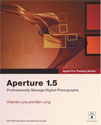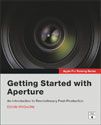
Aperture 1.5: Professional Manage Digital Photographs
by Orlando Luna and Ben Long
Peachpit Books
ISBN 0-321-49662-0
543 pages
$49.99 US, $61.99 CN £35.99 UK

Aperture: Getting Started
by Apple Computers
Peachpit Books
222 pages
Manual for Aperture Software

Aperture Exposed: The Mac Photographer’s Guide to Taming the Workflow
by Ellen Anon and Josh Anon
Sybex
ISBN 0-047-0040-19X
297 pages
$49.99 US, $61.99 CN £35.99 UK
I recently wrote about Apple’s recent update of their latest digital management software, Aperture 1.5. In that review I alluded to a couple of resourceful books about the program.
In my humble opinion, I think if you have been a heavy user of iPhoto 6 and if you have more than introductory skills using any recent version of Adobe’s Photoshop or any of Apple’s pro-life programs (like Final Cut Pro, DVD Studio Pro, Logic Pro) then Aperture will not be a steep learning curve for you. It might seem daunting at first if you’ve just been a beginning user of iPhoto, but actually, understanding Aperture’s basic structure is almost intuitive. There is, however, much to learn about using the program.
Any of the three books under review will effectively get you into and through Aperture. The first hurdle to understanding this massive program is understanding it’s structure and management tools. Many people curious about Aperture want to know why they should upgrade to from iPhoto. Well basically, Aperture is about photo management for heavy digital photography shooters. If you’re taking hundreds of photos on a regular basis and you need to make sure you have a system for managing, outputting and archiving digital photos, then Aperture is for you.
Aperture: Getting Started
The manual that comes in the Aperture is a very good introduction to the program. It’s the second Apple manual that I’ve used for one of its Apple’s professional programs, and I’m find this one equally concise, well illustrated, and comprehensive for basic steps. It opens with a useful workflow diagram that becomes more clear as you work through the program and learn its features. It illustrates the basic Aperture workflow: Acquire Images>Create Projects> Photo Edit (sort and group)>Apply Adjustments (changes in exposure, white balance, levels, etc.)>Distribute to output (export files, print, create slide show or webpages, print books)> Back Up (using Aperture Vault system.)
Each part of that workflow is explained in the manual. Screen shots fill almost every page. While you wouldn’t read this book cover to cover, and though its not tutorial based, it makes for a good reference book when you simply want to know definitions and how-tos of all the features, buttons, displays, and keywords of Aperture. Don’t look to this book for tricks and hints.
Aperture Exposed
If you’re looking for a more readable book on Aperture, Ellen and Josh Anon’s book, Aperture Exposed, is a very good introduction to the program. Like similar books published by Sybex, this one is printed in a nice 8.5×11 format with plenty of white space on each page for notes. The style of writing is both manual and real world application.
The authors take you through all the features and how-tos of the program, but they write from the perspective of photographers, providing workflow suggestions based on actual types of photo shoots. You could very well read parts this book even before you purchase the program if just wanted to get an idea of what Aperture is about or compare it to your current set up.
Nearly every page of their book contains Notes that are essentially tips and suggestions for workflow management. These tips take the book a little beyond just a manual format, which I think makes it a more valuable read. I look for this approach in software books. I don’t want pages and pages of instructions that I might find in the software manual or the PDF files that come installed with a program.
The current publication of Aperture Exposed covers Aperture 1.1, but the authors have published an update to cover Aperture’s new and very welcomed features in 1.5. You can download their update on Amazon.com. It covers how to use the new importing, archiving, and adjustment features of Aperture that are now making it a more sought after program for digital photographers.
There’s nothing I found missing in Aperture Exposed; however, if you’re looking for a tutorial approach to learning Aperture, you won’t find it in this book. The book could use some file downloads of photos used in the book which may help readers learn the some of the techniques and strategies described in the book.
Aperture 1.5: Professional Manage Digital Photographs
If indeed you’re looking for a tutorial approach to approach to Aperture, then you might try Orlando Luna and Ben Long’s Aperture 1.5, which a part of the Apple Pro Training Series.
This book comes with a DVD of tutorial files that you import for each of the book’s lessons. I haven’t followed the entire program, but I am working through some of the lessons about image adjustments and batch conversions. Ben Long has been especially helpful in this area. He has produced numerous Automator workflows for both Adobe Photoshop CS2 and Aperture. Importing the files used in the book often times helps you understand and follow along in the lesson.
This book, though, is more manual like in it’s writing. It’s better to just read and follow along with the lessons. The authors seem very comprehensive in their approach, and each chapter ends with review questions which speaks to its textbook appeal. If you purchase Aperture 1.5 on Amazon.com, you can get a discount on this more expensive book about Aperture.
Aperture: Getting Started: 4 out of 5
Aperture Exposed: 4 out of 5
Aperture 1.5: Professional Manage Digital Photographs: 3.5 our 5

Leave a Reply
You must be logged in to post a comment.